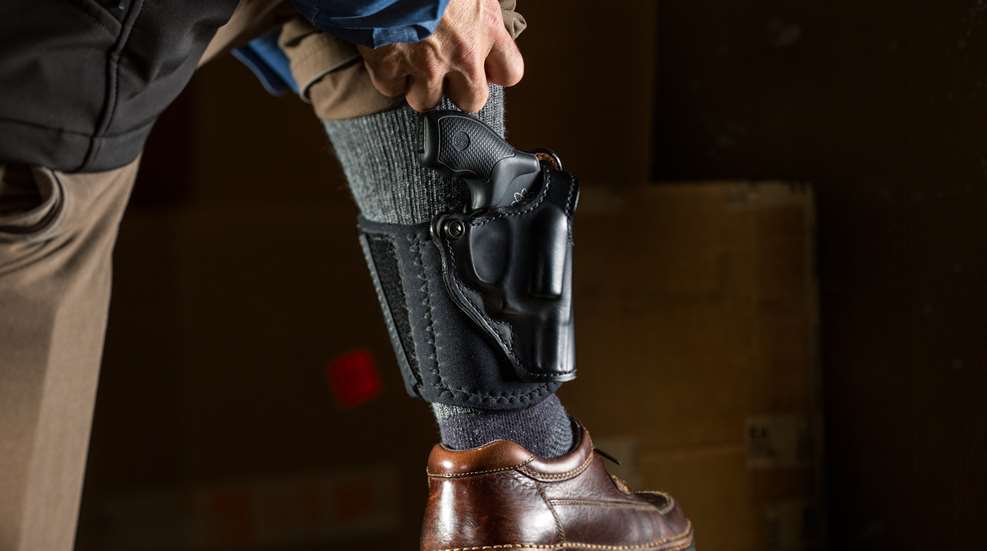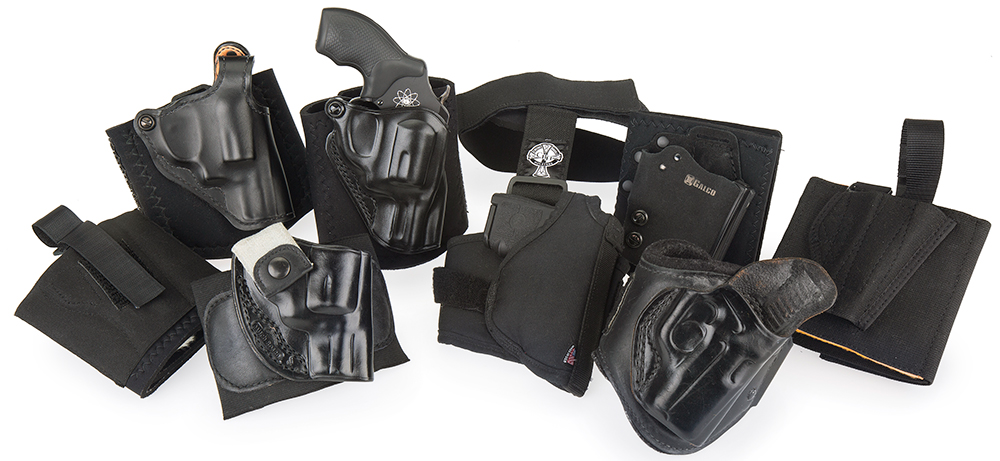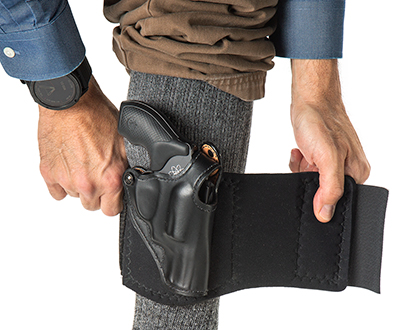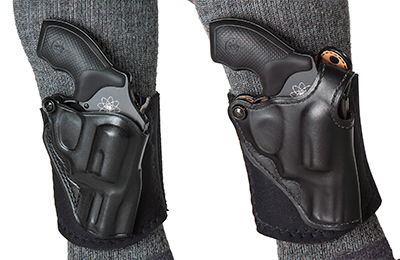
Those who know me know I’m a huge fan of carrying a firearm in an ankle holster. Sometimes it is my primary carry method, and other times I use it for carrying my backup gun. It is an excellent method for carrying concealed, as long as you adhere to a few simple conditions. If you can, then you quickly realize why it has continued to be very popular within certain circles. I’ve learned to exploit the pros when carrying on my ankle, and over the years I have reduced the cons’ interference on my overall skill significantly. The dirty secret no one likes to talk about is how it is a viable carry option, as long as you select an appropriate firearm, a secure holster and practice regularly.
I cannot recall the exact date I first carried a firearm in an ankle holster. What I remember was it felt weird. Then again, the first time I carried a firearm concealed it felt weird. The newness of carrying in this location seemed to exaggerate all the nuances. After a while, I would often forget I was carrying in an ankle holster until I took it off at the end of the day. There weren’t a lot of quality holster options back then, in fact there were only two options as I recall. Nor were there a lot of firearm options ideally suited for ankle carry. That didn’t stop me from carrying on my ankle. If anything, I took to it like a duck to water.
The primary reason I was interested in this method of carry was as an option for carrying a backup gun. I wanted something other than pocket carry or weak-side carry for the times I opted to carry a backup. I was quite happy with these options, but I found myself gravitating toward ankle carry because it also fit a niche I had discovered: carrying in formal or business attire. When circumstances and environmental conditions required to dress in a suit or tuxedo, I found it challenging to carry a firearm using traditional methods. It’s not impossible to carry strong side adhering to this type of dress code, but it was sometimes very dependent on what type of uniform I was required to wear. Regardless of the belt width, belt loop locations or the material of the trousers, carrying on the ankle seemed to circumvent those obstacles.

While we will get into the pros, I want to first discuss the cons. There are three main negatives that I have observed over the years. Two of them can be overcome with better selection of a holster and the firearm. The last is something you just have to adapt to over time.
During light physical activity it is possible—if you have selected the wrong holster—to lose retention of the firearm. While I have tried to duplicate this with my collection of ankle holsters, I have not been successful, but it is a possibility.
Next, when you sit down, you can inadvertently expose the bottom portion of the holster. If you opt for a slightly longer inseam and cuffed hems, you can mitigate these instances, along with awareness of what’s going on with your pant leg.
The biggest con for ankle carry is the drawstroke speed. Because you have to physically travel farther to obtain a firing grip, it will always be slower than just about any method that places the holster on your waistline. While there is no real way to make up the time in a side-by-side comparison, you can draw sooner by being alert to your surroundings and paying attention. Then again, in situations you cannot carry on your waistline based on the environment and wardrobe conditions, it will be the fastest because it is all you are carrying.
When you are considering carrying in an ankle holster, the first question you have to ask is: “Do I have a firearm ideally suited to be carried in this position?” Not every handgun is going to fulfill this role well. The first consideration is going to be size. My recommendation is a barrel length shorter than 3.5 inches and longer than 1.8 inches. The barrel size has a great deal to do with the overall size of the firearm. You can consider overall length, but if you stick to this parameter, you should be good.
Weight is less of an issue and something you get accustomed to over time when you adhere to the suggested barrel size. Even then, you want to keep the weight below 20 ounces unloaded. Once loaded, you can expect it to get heavier, but this is your starting point. What you will discover is most small-frame, five-shot revolvers will easily fulfill this role within these parameters. I started out carrying a snubby revolver and found it to be one of the lightest firearms to carry in the ankle holster, so if weight is a concern, this is probably a good option.
As I mentioned, after a while you get use to carrying with the weight, and with a quality holster it becomes more comfortable over time. My one complaint with the revolver is I had five rounds and then a reload. If you are willing to move up to a semi-automatic subcompact to micro-compact size, you can find some really good options without sacrificing much in terms of overall size and weight.
Things changed dynamically when I started carrying a semi-automatic. Because the manual-of-arms is more closely associated with my primary-carry handgun, it was easier to shoot and reload. I would practice shooting with these smaller firearms more regularly than with my snubby revolvers, so my accuracy was much improved, as was my speed or shot-to-shot recovery time. There were even some magazine-compatibility bonuses. Sometimes, my reload magazine would not only feed my primary, but also my backup. While I haven’t permanently retired my wheelgun, I don’t often carry it in an ankle holster much anymore.
So, what semi-automatic makes and models are we talking about here ideal for ankle carry? SIG Sauer’s P365 standard model as well as the Glock G26 and G43 models are perfect, as is the Springfield Armory Hellcat.

The last piece to the ankle-carry-firearm puzzle is its height. The height of the pistol needs to be less than 4.5 inches, and the shorter the better. What this equates to is ease of concealment and a smoother drawstroke. The taller the firearm, the longer the magazine, which can make it more likely to print. The longer magazine can also snag on your pant leg’s hem, making it more challenging to draw under pressure.
When it comes to practicing, we need to break it down into two parts; drawing and shooting. Because the typical firearm ideally suited for ankle carry is small, it often doesn’t get the same level of practice as our compact or full-size firearms. Drawing is not without its complications. And, it can be a pain to re-holster, since some holsters don’t have rigid mouths. A thin mouth means you might have to remove the holster, insert and secure the firearm, then reattach it to your ankle. Again, it can be a pain. Before you attempt any live fire, you need to invest several hours dry firing and practicing your drawstroke with a for-sure unloaded gun to make sure you are safe.

When it comes to clearing your cover garment you have three main options; you can bend over, you can take a knee and shoot or you can take a knee then stand back up to shoot. All of these options are not without their drawbacks. Bending over, while faster, means you lose sight of the threat. Taking a knee and shooting from that position means you are immobile. Taking a knee then recovering to the standing just takes more time. One solution is to practice them all and let the situation dictate the best method. An advantage that often gets overlooked is how accessible a firearm is from a seated position when it’s carried on the ankle. Whichever method you select, it will require practice.
The act of drawing from the ankle will require you to move to the firearm, clear the pant hem, acquire your firing grip, then clear the holster, move the firearm to the threat, aim and fire. Slowing down is the first step. You will want to take it slow and make sure you perform each of these steps as flawlessly as possible.
Once you’ve moved to the firearm, grasp your pant hem with both hands. Clear the pant hem by pulling straight up until the firearm is accessible. Grip the firearm and defeat any retention devices. Remove the firearm by pulling it straight up to clear the holster, then orient the muzzle towards the threat as you obtain a two-handed grip. Finish by bringing the firearm up to your sight line to confirm your sights, then manipulate the trigger to deliver an accurate shot. Again, take it slow and practice dry with an unloaded gun before going to the range.

You can separate this process and practice shooting your micro-compact firearm on a more regular basis. These smaller firearms are harder to shoot, and I’ve written several articles for this very magazine on how to master them, so I will keep this short. Focus on getting the best grip possible. They are small, so you may not get your full hand on the grip. No big deal, get as much as you can and focus instead on applying a firm grip with both hands, almost crushing. Be as precise with your aiming as possible. Small errors with these shorter barrels can translate to large misses. The triggers in many of these modern micro-compact firearms are vastly superior to their predecessors, but they still take deep concentration. Practice properly placing your trigger finger on the trigger, then practice moving the trigger smoothly to the rear. A little bit of effort on improving your shooting with your chosen firearm will pay dividends should you actually need to protect yourself.
Ankle holsters are a viable option for many, whether as a primary due to environmental and occupational conditions or serving as a backup. Should you decide to pursue this method of carry, you will want to pay close attention to the firearm you choose. The micro-compact semi-automatic handguns or five-shot snubby revolvers are the most common, as these options are easy to carry and conceal on your ankle. Once you have the ideal firearm, choosing a quality holster will require considering the duration and frequency you choose to carry in this location.
Selecting a holster with good retention is important, but so is selecting a holster that allows you to regularly practice your drawstroke without having to remove it to reholster. Practicing your drawstroke and the different methods of drawing will ensure you have the best chance at getting the firearm into the fight, but when you do, you want to be accurate and fast enough. Practicing on the range with your micro-compact firearm should be an integral part of your training. If you don’t put the effort into shooting them well, then carrying in this manner—or any other way, for that matter—makes these gun little more than a talisman. There is a reason ankle carry has been around for so long and continues to enjoy widespread use—it’s a solid and discreet option.





































